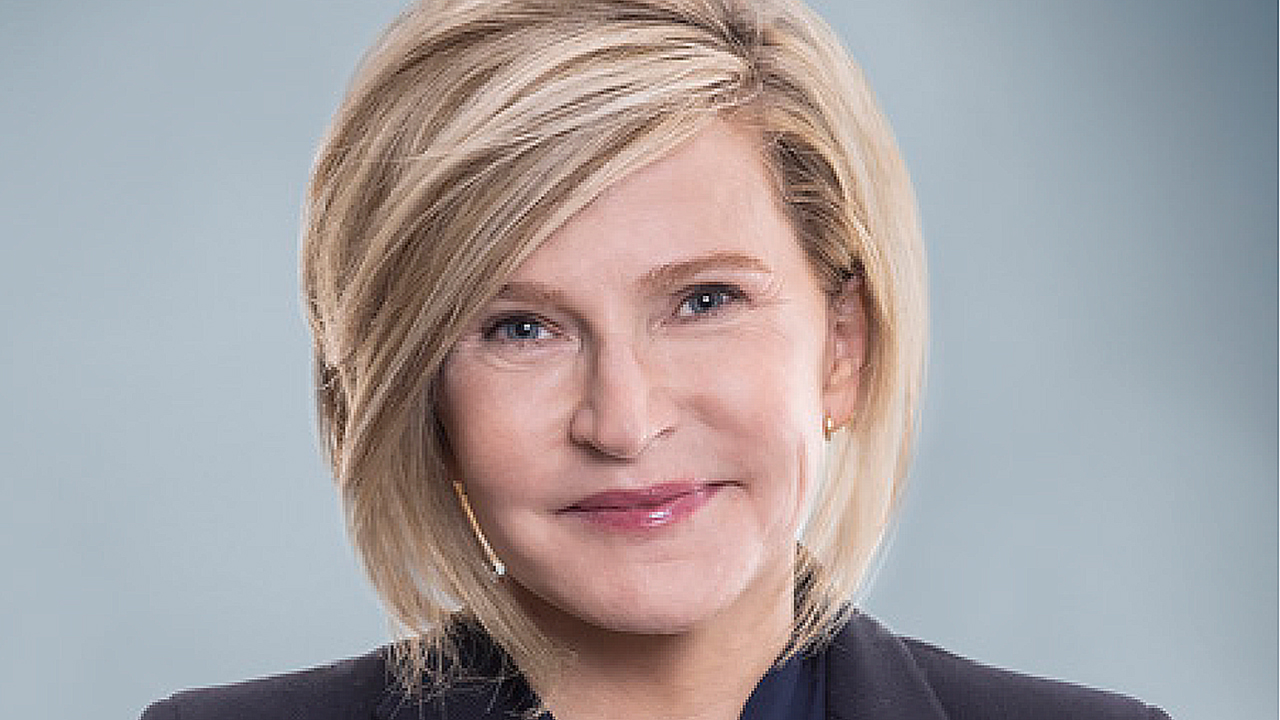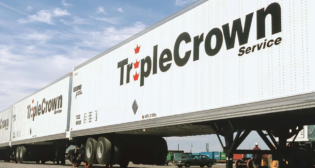
CN: Rate Increases, Fuel Surcharges Contribute to ‘Sound’ 1Q22
Written by William C. Vantuono, Editor-in-Chief
Tracy Robinson became CN President and CEO on Feb. 28, only the second woman in Class I history in that role.
CN’s financial and operating results for first-quarter 2022, a transition period during which President and CEO Tracy Robinson took the reins from the retiring JJ Ruest (Railway Age’s 2019 Railroader of the Year), were “sound,” with the company posting adjusted (non-GAAP) diluted earnings per share (EPS of C$1.32, up 7% from the prior-year-period, and diluted EPS of C$1.31, down 4%.
Compared to first-quarter 202, CN posted revenues of C$3.708 billion, an increase of C$173 million or 5%, compared to C$3.535 billion for the same period in 2021, “reflecting strong demand, despite reduced RTMs (revenue ton-miles) resulting from the significantly smaller Canadian grain crop, persistent global supply chain disruptions and challenging operating conditions, including harsher winter weather,” CN noted. “The 5% increase was mainly due to higher applicable fuel surcharge rates, freight rate increases, higher Canadian export volumes of coal via West Coast ports and higher export volumes of U.S. grain, partly offset by significantly lower export volumes of Canadian grain and lower international container traffic volumes via the ports of Vancouver and Prince Rupert.”
RTMs declined by 8% compared to the year-earlier period, but freight revenue per RTM increased by 15%, “mainly driven by a significant decrease in the average length of haul, higher applicable fuel surcharge rates and freight rate increases.”
Operating income decreased 8% to C$1.227 billion; adjusted (non-GAAP) operating income increased 4% to C$1.237 billion was an increase of 4%. The operating ratio rose 440 basis points to 66.9%; the adjusted (non-GAAP) OR rose 30 basis points to 66.6%. Non-GAAP free cash flow C$571 million compared to C$539 million for the same period in 2021. Car velocity (car-miles per day) decreased by 12%. The injury frequency rate (Per 200,000 person-hours, based on Federal Railroad Administration reporting criteria., improved by 18%, but the accident rate (Per million train miles, based on FRA reporting criteria) increased 93%. Fuel efficiency remained flat at 0.910 U.S. gallons of locomotive fuel consumed per 1,000 GTMs (gross ton-miles.
Operating expenses increased by 12% to C$2.481 billion, “mainly due to higher fuel costs due to the rapid rise in fuel prices as well as the recovery of the loss on assets held for sale recorded in the first quarter of 2021 resulting from the company entering into an agreement for the sale of non-core lines, partly offset by lower average headcount.”
2022 Outlook
Due to “challenging operating conditions in the first quarter as well as worldwide economic uncertainty,” CN now expects to deliver approximately 15-20% adjusted diluted EPS growth, compared to its Jan. 25, 2022 target of 20%. CN is now targeting an operating ratio “below 60%” for 2022, compared to its Jan. 25, 2022 target of approximately 57%, as well as approximately 15% ROIC (return on invested capital). (CN is also now targeting free cash flow in the range of C$3.7 billion-C$4.0 billion in 2022, compared to its Jan. 25, 2022 target of approximately C$4.0 billion. All of these projections are non-GAAP.
CN said it “has made a number of economic and market assumptions in preparing its 2022 outlook”:
- North American industrial production for the year will increase in the mid-single-digit range and assumes U.S. housing starts of approximately 1.6 million units and U.S. motor vehicle sales of approximately 15.5 million units.
- For the 2021/2022 crop year, the grain crop in Canada was below its three-year average, and the U.S. grain crop was in line with its three-year average. The 2022/2023 Canadian grain crop will be above its three-year average (compared to its Jan. 25, 2022 assumption that it would be in line with its three-year average) and the 2022/2023 U.S. grain crop will be in line with its three-year average.
- Total RTMs in 2022 will increase in the low-single-digit range vs. 2021.
- Continued pricing above rail inflation.
- The value of the Canadian dollar in U.S. currency will be approximately $0.80.
- The average price of crude oil (West Texas Intermediate) will be in the range of US$90-US$100 per barrel (compared to its January 25, 2022 assumption of approximately US$65-US$70 per barrel).
- CN plans to invest approximately 17% of revenues in its capital program.
“CN has an incredible tri-coastal network, the best on the continent,” said Robinson, the second woman after BNSF’s Katie Farmer named chief executive of a Class I railroad. “Our team of experienced railroaders demonstrated resilience in the first quarter, managing through severe winter weather conditions and supply chain disruptions to deliver solid results. I am encouraged by the cadence that we developed at the end of the quarter as we lifted out of winter operations. Looking ahead, our immediate focus is on restoring CN’s network to its full capacity and running a scheduled railroad with an emphasis on velocity. I am confident that we will have a strong year and deliver on our 2022 financial outlook.”
Cowen Insight: “Guidance Moves Downward Despite Strong Rail Demand”
“CNI reported a 1Q that missed our and consensus forecast due to higher fuel costs and service issues,” notes Cowen and Company Managing Director and Railway Age Wall Street Contributing Editor Jason Seidl. ”Management lowered its full-year guidance, citing challenges flowing through the network. Guidance relies on being more optimistic in 2H despite geo-political and macroeconomic concerns; we reiterate our Market Perform and lower our PT (price target).
“CNI reported a 1Q adj. EPS of $1.32 CAD, below our estimate of $1.38 CAD and the consensus forecast of $1.39 CAD. Adj. OR of 66.8% missed our forecast as management called out the lack of fluidity and higher fuel costs as the source of margin pressure in the quarter. Indeed, fuel cost was a large driver of increasing operating expenses, and management cited that it led to a $0.07 of negative EPS in the quarter due to the fuel surcharge lag (we previously modeled a large step-up in fuel when we updated our rail estimates in March). They also noted that weather impacted the quarter more in 1Q22 than the prior year, but failed to give an exact impact.
“Volumes on an RTM basis were down ~8%, led by grain (down ~18%) from the weak Canadian grain cycle. We expect gain to pick up in the Fall, and this year’s crop is looking more normalized. Intermodal volumes were down nearly 13% in 1Q, although our railshare data suggests an improvement within intermodal volumes quarter-to-date. Management shared optimism that operating momentum has picked up from mid-March and through April. Overall, it appears that demand continues to be very strong in early 2Q, which is encouraging after the quarter that was just logged.
“CNI revised its 2022 financial outlook downwards, now expecting operating ratio to be below 60% (previously CNI targeted ~57%), suggesting a 300bp headwind. Although management did not discuss in any significant detail on the call, we believe the preponderance of this pressure is coming from fuel, 1Q weather impacts and increased headcount (CNI is in the process of aggressively hiring across its network). Overall adjusted EPS is now expected to grow 15%-20%, down from ~20% previously. Following the call, we remain somewhat concerned about the full year as a lot of emphasis is being placed on earnings in 2H despite notable geopolitical and macro-economic concerns.
“We Adjust our 2022 and 2023 EPS estimates to $5.45 USD from $5.63 USD and $5.90 USD from $6.25 USD, respectively. We lower our multiple a turn to 21.5x due to our macro concerns. Accordingly, our price target goes to $127 USD from USD $141. Reiterate Market Perform.”



